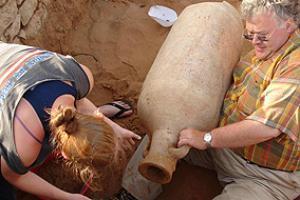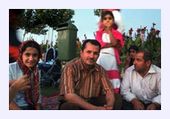University of British Columbia archaeologists have dug up a mystery worthy of Indiana Jones, one that includes a tomb, skeletons and burial rites with both Christian and pagan elements.
This summer, Prof. Roger Wilson led excavations at Kaukana, an ancient Roman village located near Punta Secca, a small town in the south-eastern province of Ragusa in Sicily.

© Roger WilsonArcheologist Roger Wilson pulls out the clay amphora from its 1,500 year hiding place.
Combing through the sand-buried site, the 15-member team made a series of startling discoveries. Central to the mystery was finding a tomb inside a room in a house dating from the sixth century AD.
Wilson explains that tombs during this period are normally found only in cemeteries outside the built-up area of a town, or around the apse of a church. And since the building was substantial with mortared walls and internal plaster, this would have been likely a tomb for the wealthy.

